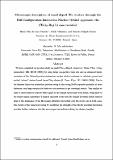Por favor, use este identificador para citar o enlazar a este item:
http://hdl.handle.net/10261/21764COMPARTIR / EXPORTAR:
 SHARE
BASE SHARE
BASE
|
|
| Visualizar otros formatos: MARC | Dublin Core | RDF | ORE | MODS | METS | DIDL | DATACITE | |

| Campo DC | Valor | Lengua/Idioma |
|---|---|---|
| dc.contributor.author | Lara Castells, María Pilar de | - |
| dc.contributor.author | Villarreal, Pablo | - |
| dc.contributor.author | Delgado Barrio, Gerardo | - |
| dc.date.accessioned | 2010-03-01T12:21:06Z | - |
| dc.date.available | 2010-03-01T12:21:06Z | - |
| dc.date.issued | 2010-02-08 | - |
| dc.identifier.citation | International Journal of Quantum Chemistry (2010) | en_US |
| dc.identifier.uri | http://hdl.handle.net/10261/21764 | - |
| dc.description.abstract | We have completed our previous study on small (3He)N-Br2(X) clusters [J. Chem. Phys. (Communication) 125, 221101 (2006)] by using larger one-particle basis sets and an enhanced implementation of the full-configuration-interaction nuclear orbital treatment to calculate ground and excited ``solvent" states of small doped $^{3}$He$_N$ clusters [J. Chem. Phys. {\bf 131}, 194101 (2009)]. Due to the inherent hard-core interaction problem owing to the strong He-He repulsive potential at short distances, very large one-particle basis sets are necessary to get converged results. Very similar results to those found for clusters with Cl$_{2}$($B$) as the dopant species have been found, owing more to the rather similar anisotropic T-shaped character of the used He-dopant potential energy surfaces than to the dominance of the He-dopant attractive interaction over the He-He one in both cases. The results of the numerical testing by modifying the strength of the He-He potential interaction provides further evidences into the microscopic interactions holding the clusters together. | en_US |
| dc.description.sponsorship | This work has been partially supported by the CSIC-CAM, CICYT, and MICINN-CSIC Spanish Grants Nos. CCG08-CSIC/ESP-3680, FIS2007-62006, and 2007501004.The Centro de Supercomputación de Galicia (CESGA) and the Centro de Supercomputación y Visualizaci ón de Madrid (Ref. AB01101001) are acknowledged for allocation of computer time. | en_US |
| dc.format.extent | 441860 bytes | - |
| dc.format.mimetype | application/pdf | - |
| dc.language.iso | eng | en_US |
| dc.rights | openAccess | en_US |
| dc.title | Microscopic description of small doped 3He clusters through the Full-Configuration-Interaction Nuclear Orbital approach: the (3He)N-Br2(X) case revisited | en_US |
| dc.type | artículo | en_US |
| dc.description.peerreviewed | Peer reviewed | en_US |
| dc.type.coar | http://purl.org/coar/resource_type/c_6501 | es_ES |
| item.languageiso639-1 | en | - |
| item.fulltext | With Fulltext | - |
| item.openairecristype | http://purl.org/coar/resource_type/c_18cf | - |
| item.cerifentitytype | Publications | - |
| item.grantfulltext | open | - |
| item.openairetype | artículo | - |
| Aparece en las colecciones: | (CFMAC-IFF) Artículos | |
Ficheros en este ítem:
| Fichero | Descripción | Tamaño | Formato | |
|---|---|---|---|---|
| br2he3-rev.pdf | 431,5 kB | Adobe PDF |  Visualizar/Abrir |
CORE Recommender
Page view(s)
258
checked on 23-abr-2024
Download(s)
100
checked on 23-abr-2024
Google ScholarTM
Check
NOTA: Los ítems de Digital.CSIC están protegidos por copyright, con todos los derechos reservados, a menos que se indique lo contrario.
